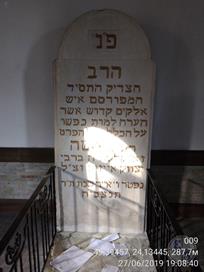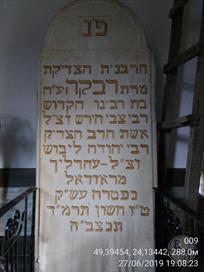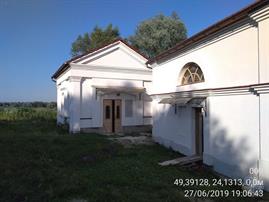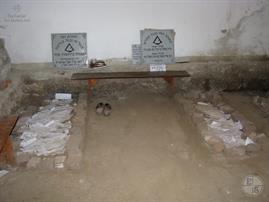Zhydachiv
Stryi district, Lviv region
 |
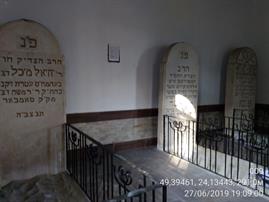 |
| Ohel of rabbi Tzvi Hirsh on Jewish cemetery in Zhydachiv, 2019 | Except r. Tzvi Hirsh, there are also several graves here |
Sources:
- Pinkas Hakehillot Polin: Encyclopedia of Jewish Communities, Poland, Volume II, page 215-216, published by Yad Vashem, Jerusalem. Translated by Jewish Galicia & Bukovina N.P.O
Photo:
- European Jewish Cemeteries Initiative. Published by Center for Jewish art
- Pinkas Hakehillot Polin: Encyclopedia of Jewish Communities, Poland, Volume II, page 215-216, published by Yad Vashem, Jerusalem. Translated by Jewish Galicia & Bukovina N.P.O
Photo:
- European Jewish Cemeteries Initiative. Published by Center for Jewish art
Zhydachiv is located on the eastern bank of the Stryi River, not far from its confluence with the Dniester River. Zhydachiv sits on the main route between Stryi and Rohatyn, about 45 kilometers south of Lvov. This city was, already in 1387, the possession of the polish king, and it received city rights from King Władysław Jagiełło in 1393, and was given to his brother, Prince Bolesław, together with the rest of the county.
Its geographical location forced the polish kings to fortify the city against attacks by the Tatars and Ottomans, who destroyed it several times. Out of an attempt to better the financial situation of the city, Zhydachiv received, in 1546, the right to hold three further fairs a year. One of the main financial branches in the city was the salt trade, in addition to the sale of the agricultural produce of the manors and villages attached to the city.
Jews lived in Zhydachiv before the middle of the 15th century, when we first hear of specific Jews from Zhydachiv. During the 1460s a Jew by the name of Shimshon of Zhydachiv was a resident of the city and an important leaser and merchant, who lent out large sums of money. As thanks for his faithfulness and aid in the financial development of the country, R. Shimshon of Zhydachiv received the salt mines in Dolyna from King Kazimierz Jagiellończyk on lease for three years.
The Jews of Zhydachiv made their livelihood primarily through trade, different types of leasing and the production and sale of alcoholic beverages.
In the 18th century, the community of Zhydachiv was one of the central communities in the region, and among others was responsible for the community of Bolekhiv (Bolechow), which is located about 40 kilometers away from it.
The community of Zhydachiv is known primarily thanks to the prominent Hasidic leader Rabbi Tzvi Hirsh Eichenstein, the Rebbe of Zhydachiv, who was active in all of eastern Galicia during the 19th century.
Rabbi Tzvi Hirsh was a prominent figure in the battle against the first Jewish Enlightenment figures in Galicia, and primarily his opponent, Joseph Perl.
The latter complained and informed against R. Tzvi Hirsh several times, out of an understanding that his activity was harmful to the German-speaking school he started in Tarnopol (about 150 kilometers east of Zhydachiv). Indeed, R. Tzvi Hirsh is mentioned by many Enlightenment figures as an opponent of theirs, and many of them complained of him to the authorities, and even led to his banishment from at least one city.
On the other hand, there were those who viewed him as ‘a man who has it in his power to lead 100,000 of Israel’. R. Hirsh even influenced the appointment of ritual slaughterers in various communities, and was invited by the Austrian authorities to a conference of rabbis due to his status and influence.
R. Hirsh exhorted others to learn Kabbalah, and even printed kabbalistic works, including his own compositions in kabbalah, in addition to his Talmudic learning.
R. Hirsh’s two nephews – R. Yitzhak Aizik of Zhydachiv and R. Yitzhak Aizik Yehuda Yehiel Safrin of Komarno – were among his spiritual heirs, as was his student, R. Zvi Elimelech of Dynow. All three developed large Hassidic courts around them, and were very prolific in the realm of kabbalistic and Talmudic writing, as well as being known as miracle workers.
R. Zvi Hirsh demanded intellectual independence and critical thinking of his students, and these traits are notable in the works of R. Yitzak Aizik of Komarno as well. Members of the Eichenstein family continued to serve as Hassidic rebbes in Zhydachiv until the Second World War.
In 1906 a Jew, who garnered the support of Polish and Ukrainian residents as well, was chosen to serve as the mayor of Zhydachiv.
During this time Zionist activity began in the city as well, and a branch of the organization ‘Tikvat Zion’ was founded there in 1907.
Its geographical location forced the polish kings to fortify the city against attacks by the Tatars and Ottomans, who destroyed it several times. Out of an attempt to better the financial situation of the city, Zhydachiv received, in 1546, the right to hold three further fairs a year. One of the main financial branches in the city was the salt trade, in addition to the sale of the agricultural produce of the manors and villages attached to the city.
Jews lived in Zhydachiv before the middle of the 15th century, when we first hear of specific Jews from Zhydachiv. During the 1460s a Jew by the name of Shimshon of Zhydachiv was a resident of the city and an important leaser and merchant, who lent out large sums of money. As thanks for his faithfulness and aid in the financial development of the country, R. Shimshon of Zhydachiv received the salt mines in Dolyna from King Kazimierz Jagiellończyk on lease for three years.
The Jews of Zhydachiv made their livelihood primarily through trade, different types of leasing and the production and sale of alcoholic beverages.
In the 18th century, the community of Zhydachiv was one of the central communities in the region, and among others was responsible for the community of Bolekhiv (Bolechow), which is located about 40 kilometers away from it.
The community of Zhydachiv is known primarily thanks to the prominent Hasidic leader Rabbi Tzvi Hirsh Eichenstein, the Rebbe of Zhydachiv, who was active in all of eastern Galicia during the 19th century.
Rabbi Tzvi Hirsh was a prominent figure in the battle against the first Jewish Enlightenment figures in Galicia, and primarily his opponent, Joseph Perl.
The latter complained and informed against R. Tzvi Hirsh several times, out of an understanding that his activity was harmful to the German-speaking school he started in Tarnopol (about 150 kilometers east of Zhydachiv). Indeed, R. Tzvi Hirsh is mentioned by many Enlightenment figures as an opponent of theirs, and many of them complained of him to the authorities, and even led to his banishment from at least one city.
On the other hand, there were those who viewed him as ‘a man who has it in his power to lead 100,000 of Israel’. R. Hirsh even influenced the appointment of ritual slaughterers in various communities, and was invited by the Austrian authorities to a conference of rabbis due to his status and influence.
R. Hirsh exhorted others to learn Kabbalah, and even printed kabbalistic works, including his own compositions in kabbalah, in addition to his Talmudic learning.
R. Hirsh’s two nephews – R. Yitzhak Aizik of Zhydachiv and R. Yitzhak Aizik Yehuda Yehiel Safrin of Komarno – were among his spiritual heirs, as was his student, R. Zvi Elimelech of Dynow. All three developed large Hassidic courts around them, and were very prolific in the realm of kabbalistic and Talmudic writing, as well as being known as miracle workers.
R. Zvi Hirsh demanded intellectual independence and critical thinking of his students, and these traits are notable in the works of R. Yitzak Aizik of Komarno as well. Members of the Eichenstein family continued to serve as Hassidic rebbes in Zhydachiv until the Second World War.
In 1906 a Jew, who garnered the support of Polish and Ukrainian residents as well, was chosen to serve as the mayor of Zhydachiv.
During this time Zionist activity began in the city as well, and a branch of the organization ‘Tikvat Zion’ was founded there in 1907.
The First World War
Unlike other communities, the community of Zhydachiv was not hardly hit during the First World War, to which the stable number of Jews in the city testifies.
The economic activity of the Jews of Zhydachiv was also not seriously affected, as it was in other cities in central Galicia.
Between the two World Wars, the Jews of Zhydachiv engaged in trade, peddling, various crafts and a little bit of agricultural, and some worked as hired workers.
In the elections of 1927, the representatives of ‘the National Jewish Block’ were chosen to the city council, headed by the rabbi of the city, R. Eliyahu Eichenstein, who was a member of the Hassidic rebbes’ family.
In this elections ‘Agudath Israel’ collaborated with the Polish National Democratic Party’, a party that supported antisemitism in the 30s.
In 1933 only one Jew was elected to the city council.
The Second World War
With the outbreak of the war and the Soviet conquest, Jewish merchants and artisans were forced to unionize, and some Jews were employed in the city administration. All forms of political activity were forbidden, similarly to other Galician communities in the Soviet territories.
On 03.07.1941, Nazi German forces entered Zhydachiv, and with their entry Ukrainian nationalists began harassing Jews, stealing Jewish property and attacking and at times even murdering Jews from Zhydachiv and the surrounding villages. Jews were forced to mark themselves as Jewish, their freedom of movement was curtailed, and many were sent to undertake various forced-labor enterprises.
In the autumn of 1941, Jewish youths from Zhydachiv were sent to labor camps, and in the summer of 1942 some families were moved to Stryi.
On 04-05.09.1942, several hundred Zhydachiv Jews were sent to the Belzec extermination camp, and at the end of that month the remainder of the city’s Jews were sent to the Stryi ghetto and Zhydachiv was declared ‘Judenrein’ – clean of Jews.
A few of the Jews who succeeded in escaping to the forests and hiding out there were killed by the Ukrainian farmers or handed over to the Nazi’s, and only a few of Zhydachiv’s Jews survived the war.
Unlike other communities, the community of Zhydachiv was not hardly hit during the First World War, to which the stable number of Jews in the city testifies.
The economic activity of the Jews of Zhydachiv was also not seriously affected, as it was in other cities in central Galicia.
Between the two World Wars, the Jews of Zhydachiv engaged in trade, peddling, various crafts and a little bit of agricultural, and some worked as hired workers.
In the elections of 1927, the representatives of ‘the National Jewish Block’ were chosen to the city council, headed by the rabbi of the city, R. Eliyahu Eichenstein, who was a member of the Hassidic rebbes’ family.
In this elections ‘Agudath Israel’ collaborated with the Polish National Democratic Party’, a party that supported antisemitism in the 30s.
In 1933 only one Jew was elected to the city council.
The Second World War
With the outbreak of the war and the Soviet conquest, Jewish merchants and artisans were forced to unionize, and some Jews were employed in the city administration. All forms of political activity were forbidden, similarly to other Galician communities in the Soviet territories.
On 03.07.1941, Nazi German forces entered Zhydachiv, and with their entry Ukrainian nationalists began harassing Jews, stealing Jewish property and attacking and at times even murdering Jews from Zhydachiv and the surrounding villages. Jews were forced to mark themselves as Jewish, their freedom of movement was curtailed, and many were sent to undertake various forced-labor enterprises.
In the autumn of 1941, Jewish youths from Zhydachiv were sent to labor camps, and in the summer of 1942 some families were moved to Stryi.
On 04-05.09.1942, several hundred Zhydachiv Jews were sent to the Belzec extermination camp, and at the end of that month the remainder of the city’s Jews were sent to the Stryi ghetto and Zhydachiv was declared ‘Judenrein’ – clean of Jews.
A few of the Jews who succeeded in escaping to the forests and hiding out there were killed by the Ukrainian farmers or handed over to the Nazi’s, and only a few of Zhydachiv’s Jews survived the war.

- Home
- Shtetls
- Vinnytsia region
- Volyn region
- Dnipro region
- Donetsk region
- Zhytomyr region
- Zakarpattia region
- Zaporizhzhia region
- Ivano-Frankivsk region
- Kyiv region
- Kropyvnytskyi region
- Luhansk region
- Lviv region
- Mykolayiv region
- Odessa region
- Poltava region
- Rivne region
- Sumy region
- Ternopil region
- Kharkiv region
- Kherson region
- Khmelnytskyi region
- Chernihiv region
- Chernivtsi region
- Cherkasy region
- Crimea
- Synagogues
- Cemeteries
- Objects & guides
- Old photos
- History
- Contact
Jewish towns of Ukraine
Jewish towns of Ukraine
My shtetl
My shtetl
Donate

